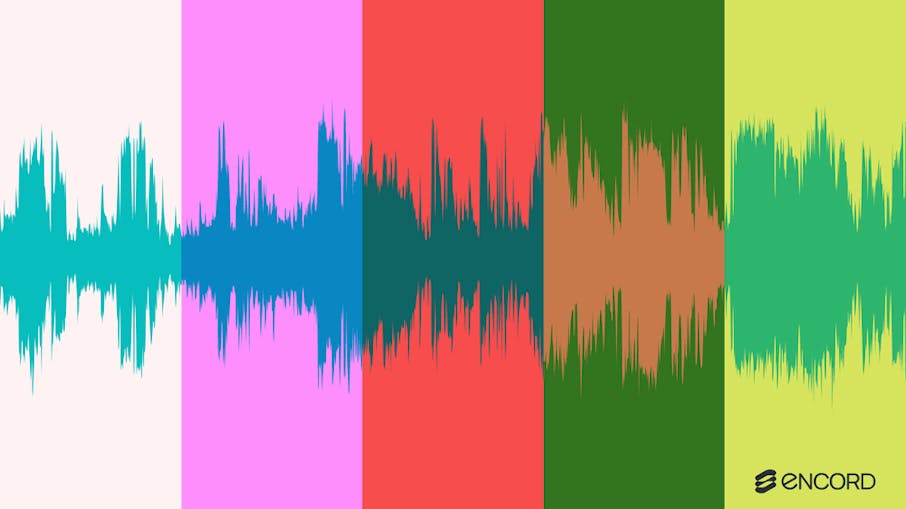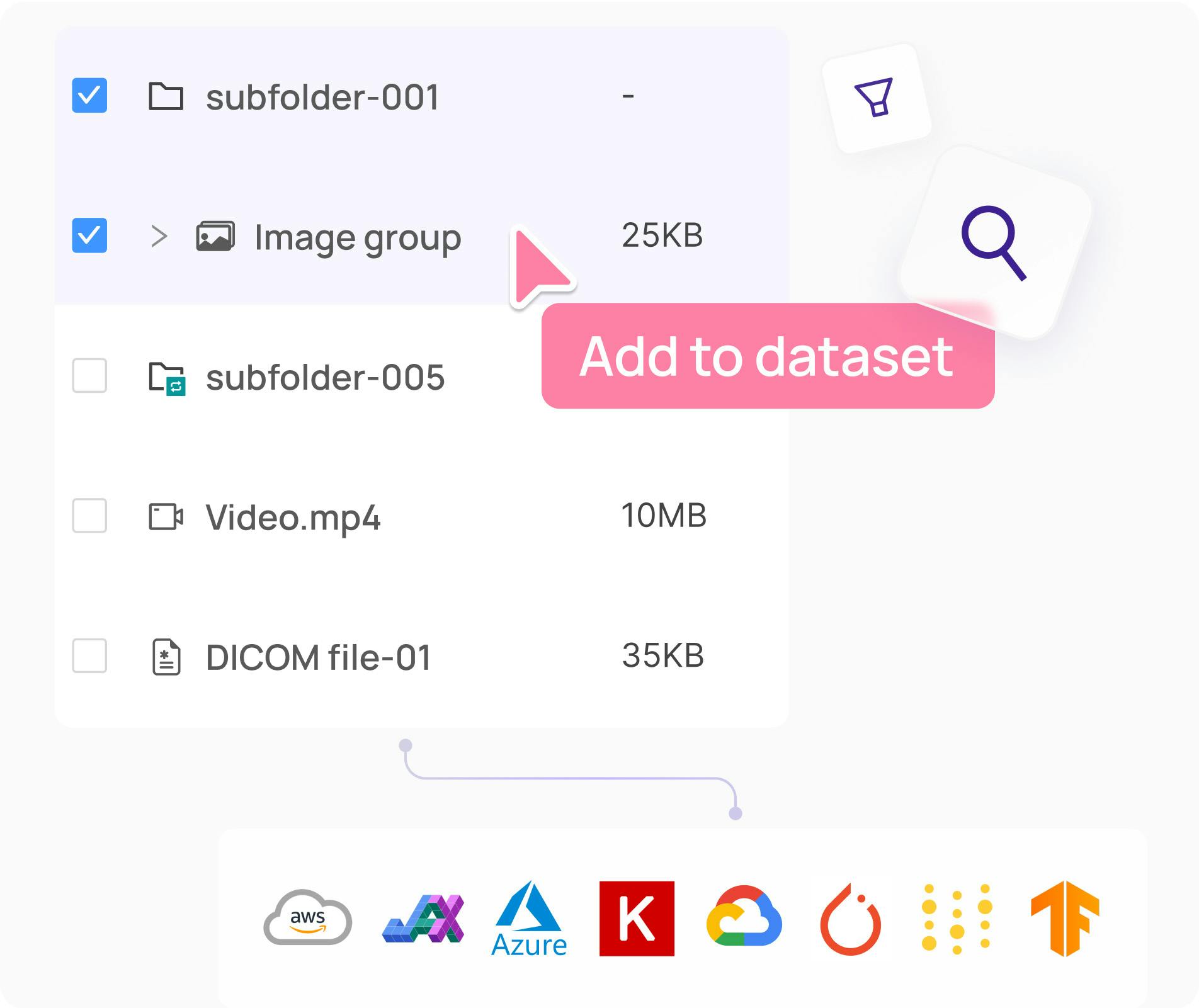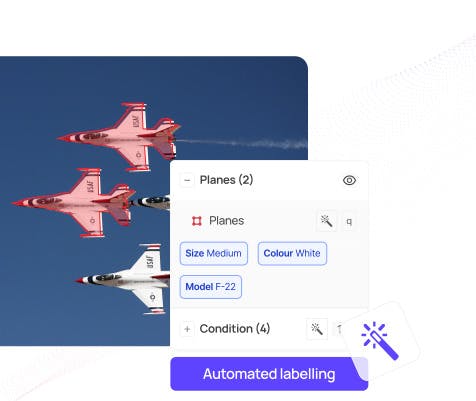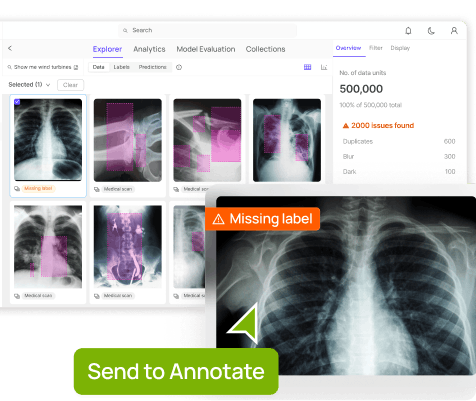Contents
Audio Segmentation - A Brief Overview
Types of Audio Segmentation
How Audio Segmentation Works
Applications of Audio Segmentation Across Industries
Challenges in Audio Segmentation
How Encord is Used for Audio Segmentation
Audio Applications of Encord
Key Takeaways
Encord Blog
Audio Segmentation for AI: Techniques and Applications
5 min read

Imagine your voice assistant flawlessly transcribing every word in a noisy meeting or a security system instantly detecting the sound of a potential threat like a gunshot. Audio segmentation is the crucial element that is turning such ideas into reality, leveraging artificial intelligence (AI) to process different sound types.
This technology is driving significant advancements in the audio AI industry, fuelling the demand for several audio AI solutions. For instance, according to MarketsandMarkets, the current global speech and voice recognition market is projected to reach USD 73.49 billion by 2030.
The core concept behind audio segmentation is to split audio recordings into distinct, homogeneous segments. It enables AI to interpret between various audio components, such as speech, music, and environmental sounds.
While it may sound straightforward in principle, audio segmentation presents several challenges, such as overlapping sounds, poor audio quality, and the need for carefully annotated datasets.
In this post, we will explore audio segmentation and its techniques, applications, and challenges. We will also see how tools like Encord can help developers segment audio to build scalable audio AI systems.
Audio Segmentation - A Brief Overview
Audio segmentation divides an audio signal into contiguous segments for AI to process. It identifies parts of the audio where the sound stays relatively consistent, like speech, music, or silence.
Each segment should ideally contain a single type of sound event or acoustic characteristic. For example, in a conversation recording, segmentation can identify speech segments from different speakers, periods of silence, or any background noise present. Audio segmentation relies on several key concepts:
- Segments: These are the audio units resulting from segmentation, each representing a specific part of the recording.
- Boundaries: These are the temporal points that mark the start and end of a segment, defining where one acoustic event ends and another begins.
- Labels/Categories: After identifying a segment, it is usually given a label or category that describes its content. This might include the speaker's name, the nature of the sound event (e.g., "dog bark," "car horn"), or a description of the acoustic environment (e.g., "office," "park").

Types of Audio Segmentation
Audio segmentation categorizes audio signals into distinct types for targeted AI processing. Below are some key types:
- Speaker Diarization: This type focuses on answering "Who spoke when?". It includes segmenting an audio stream to identify individual speakers and determine the time intervals each person speaks. This is useful in meetings, interviews, and multi-party conversations for indexing and understanding the flow of dialogue.
- Environmental Sound Event Detection: The goal is to identify and label specific audio events occurring within an audio signal. Examples include detecting the sound of a car horn, a dog barking, or glass breaking. Effective sound event detection depends on algorithms that distinguish these events from general background noise within the audio files.
- Music Structure Analysis: This includes segmenting a piece of music into its constituent structural elements, including the intro, verse, chorus, bridge, and outro sections. Music information retrieval uses this type of audio segmentation to understand the composition and organization of musical pieces by analyzing patterns in the waveform and other features of the audio data.
- Speech Segmentation: This type is fundamental to automatic speech recognition (ASR) and aims to divide spoken language into smaller, linguistically meaningful units. These units range from individual phonemes (the smallest sound units) to words or even entire sentences.
- Acoustic Scene Classification: This type of audio classification focuses on identifying the overall acoustic environment of an audio recording. Algorithms analyze the characteristics of the audio stream to classify the recording as taking place in an office, a park, a restaurant, or another defined acoustic scene. This has important applications in context-aware systems and multimedia analysis.
How Audio Segmentation Works
The process of audio segmentation involves several stages. It begins with the pre-processing step, which cleans up the audio signal by reducing noise and normalizing the audio levels. This enhances the quality of the audio data and prepares it for subsequent analysis.
Next, feature extraction techniques are applied to the preprocessed audio stream. The goal here is to extract relevant information from the waveform that can be used to differentiate between different acoustic events or segments.

Acoustic waveform characteristics
Common feature extraction methods include Mel-Frequency Cepstral Coefficients (MFCCs), which represent the short-term power spectrum of sound.
Another method is spectrograms, which visually depict the audio signal's frequency content over time. These extracted features are represented as vectors, which are numerical representations of an audio signal. These vectors distill complex audio data into manageable forms that ML algorithms process and analyze effectively.

After feature extraction, segmentation methods identify the boundaries between different segments based on some criteria. Audio segmentation methods can be classified into two primary approaches: supervised and unsupervised methods. Below, we’ll explore each approach and the techniques within them.
Supervised Methods
Supervised methods rely on labeled training data, where each segment is annotated with its class or boundary information. These methods use this data to train algorithms and to predict segment boundaries in new audio streams. While effective, they require significant resources to create large, annotated datasets. Within supervised learning, several techniques are used:
ML-Based Techniques:
- Hidden Markov Models (HMMs): These model the statistical properties of audio sequences, learning transitions between segments. They’re widely used in tasks like speaker diarization.
- Gaussian Mixture Models (GMMs): These treat observed data as a mix of Gaussian distributions, each representing a cluster in feature space, aiding in segment classification.
Deep Learning Approaches:
- Convolutional Neural Networks (CNNs): These analyze spectrograms for pattern recognition, excelling in tasks like acoustic event detection.
- Recurrent Neural Networks (RNNs): Including Long Short-Term Memory (LSTM) units, RNNs capture temporal dependencies in audio signals. For example, a study at the IEEE International Conference on Acoustics, Speech, and Signal Processing (ICASSP) demonstrated Bidirectional LSTMs with Attention mechanisms effectively segmenting heart sounds.
Advanced Deep Learning Methods:
- Mamba-Based Segmentation Models: The Mamba architecture space model with attention-like capabilities processes long audio sequences with reduced memory requirements. This makes it suitable for identifying speaker turns in extended recordings.
- You Only Hear Once (YOHO) Algorithm: YOHO treats audio segmentation as a regression problem, predicting the presence and boundaries of audio classes directly. This approach improves speed and accuracy over traditional frame-based classification methods.
- Audio Spectrogram Transformer (AST): AST applies transformer models to audio spectrograms for classification tasks. Due to their self-attention mechanisms, ASTs are computationally intensive.

Audio spectrogram transformer (AST) architecture
Unsupervised Methods
Unsupervised methods don’t use labeled data. Instead, they identify segment boundaries by detecting patterns or changes in the audio signal, often through clustering or similarity analysis. While they’re valuable when labeled data is unavailable, they may lack the precision of supervised methods due to the absence of training guidance. Common techniques include:
- Threshold-Based Segmentation: This compares feature values against predefined thresholds or metrics (e.g., similarity between adjacent windows) to detect changes, with local maxima indicating segment boundaries.
- Clustering Algorithms: Methods like K-means or hierarchical clustering group similar audio frames based on feature similarity, revealing natural transitions. These are often applied in music structure analysis or environmental sound detection.
Applications of Audio Segmentation Across Industries
Audio segmentation drives multiple industries by helping analyze and interpret audio data. Its applications cover various sectors, improving functionality and user experience.
Speech Technology
Audio segmentation helps various speech-based technologies. Transcription services depend on segmenting audio files into smaller units to convert speech to text. Voice assistants use it to isolate and process user commands from background noise.
Call centers use audio segmentation for analytics, such as identifying periods of silence, speaker changes, and key phrases within customer interactions.

Security and Surveillance
In security systems, audio segmentation helps detect specific sound events that may indicate anomalies or threats.
For instance, algorithms can be trained to identify the distinct waveform of a gunshot or the sound of breaking glass within an audio recording, triggering alerts for real-time response.
Media and Entertainment
Audio segmentation benefits the media and entertainment industry significantly. It powers automated music information retrieval systems that can analyze and categorize vast music libraries based on their structure, identifying intros and choruses.
Similarly, sound event detection through segmentation methods allows for efficient indexing and retrieval of specific sound effects in multimedia content.
Healthcare
Healthcare professionals are using audio segmentation for various analytical purposes. They can identify patterns indicative of certain medical conditions by segmenting patient vocalizations. Another growing application is monitoring respiratory sounds, such as coughs or wheezes, through audio stream analysis.
Education
Educational platforms can use audio segmentation capabilities to enhance learning experiences. Analyzing student participation in online discussions by segmenting individual contributions can provide insights into engagement levels.
Furthermore, automated feedback on pronunciation can be facilitated by segmenting spoken words into phonemes and comparing them against a reference, often in conjunction with ASR technology.
Challenges in Audio Segmentation
Audio segmentation faces several challenges that impact its accuracy and effectiveness:
- Overlapping Sounds: In real-world environments, multiple audio sources can overlap, making it difficult to distinguish individual sound events. For example, sounds such as doorbells, alarms, and conversations can overlap in a home setting, complicating the segmentation process.
- Variability in Audio Quality: Differences in recording devices, environments, and conditions lead to inconsistencies in audio quality. Factors such as background noise, echo, and distortion can degrade the performance of segmentation algorithms, especially those relying on subtle audio features.
- Need for High-Quality Annotated Datasets: Training effective audio segmentation models requires large datasets with precise annotations. However, creating these datasets is labor-intensive and time-consuming. The lack of standardized, high-quality annotated data hampers the development and evaluation of robust segmentation systems.
How Encord is Used for Audio Segmentation
An advanced annotation tool like Encord can help overcome the challenges mentioned above. Encord is a data curation, annotation and evaluation platform for AI. It’s audio annotation feature segments audio files for speaker recognition and sound event detection applications. Its capabilities enable the precise classification of audio attributes and accurate temporal annotations.
Comprehensive Audio File Format Support
The platform supports various audio formats, including .mp3, .wav, .flac, and .eac3, allowing seamless integration with existing data workflows. You can upload audio files through Encord's interface or SDK, connecting to cloud storage solutions like AWS, GCP, Azure, or OTC for efficient data management.
Precision Labeling and Layered Annotations
Encord's label editor supports detailed classification with millisecond-level precision, allowing annotators to accurately label sound events, emotional tone in speech, languages, and speaker identities.
Its ability to handle layered and overlapping annotations is particularly effective for applications involving complex audio streams, such as audio classification tasks where multiple events may co-occur. This functionality supports advanced use cases in multimedia indexing, sound event detection, and speech segmentation.
Temporal Classification for AI Training
Another key feature is temporal classifications, which allow annotators to label specific time segments corresponding to individual speakers or sound events. This helps enhance AI training and model optimization in applications like transcription services, virtual assistants, and security systems.
AI-Assisted Annotation for Efficiency
Encord also offers AI-assisted annotation tools that automate parts of the labeling process, increasing efficiency and accuracy. These tools can pre-label audio data, identifying spoken words, pauses, and speaker identities, thereby reducing manual effort.
Foundational models, such as OpenAI’s Whisper and Google’s AudioLM, can achieve breakthrough performance in several actions to accelerate audio curation and annotation workflows.

Label complex audio using Flixble Ontologies
AI teams can use Encord Agents to integrate with new models as well as their own, orchestrating automated audio transcription, pre-labeling, and quality control to significantly enhance the efficiency and quality of their audio data pipelines.
Collaborative Annotation and Quality Control
Integrated collaboration tools within Encord facilitate team-based projects by providing features like real-time progress tracking, change logs, and review workflows. This ensures teams can work together effectively, maintaining high-quality annotations across complex audio datasets.
Audio Applications of Encord
Encord's platform provides a robust environment for annotating audio data, directly supporting the development and enhancement of various audio-centric AI applications.
Development of Voice Assistants and Chatbots
Encord can help create high-performing voice assistants and chatbots by enabling the accurate annotation of speech audio data. Its precise temporal labeling features help label spoken words and phrases, crucial for training automatic speech recognition (ASR) models.
Encord helps build more context-aware and personalized conversational AI agents by enabling detailed annotation of who is speaking and when (speaker diarization).
Furthermore, the ability to annotate various audio attributes helps developers train models that can understand not just the content of the speech but also its nuances and characteristics.

Enhancing Emotion Recognition Systems
Encord can significantly improve the accuracy of emotion recognition systems. This detailed annotation of sentiment and emotion in audio files provides the high-quality training set required for deep learning models. These models can accurately identify and classify a wide range of emotions from audio data. Handling overlapping annotations is particularly valuable in emotion recognition, where multiple emotions or intensities might be present simultaneously in an audio stream.

Sentiment or Emotion Annotation
Key Takeaways
Audio segmentation transforms industries through AI to process audio signals accurately. It powers transcription, security, and healthcare with precise segment labeling.
- Best Use Cases for Audio Segmentation: It excels in speaker recognition for voice assistants, sound event detection for surveillance, and emotion analysis in call centers.
- Challenges in Audio Segmentation: Overlapping sounds, poor audio quality, and dataset annotation demands hinder performance.
- Encord for Audio Segmentation: Encord’s tools enhance audio data quality with AI-assisted annotation and temporal precision. It streamlines datasets for deep learning, ensuring scalable, high-performing audio AI systems.
Explore the platform
Data infrastructure for multimodal AI
Explore product
Explore our products
- Audio segments are portions of an audio signal divided based on specific features, such as speech, music, or silence, to facilitate analysis.
- Sound segmentation involves dividing an audio signal into distinct sections, each representing a specific type of sound, like speech or music, for further processing.
- Sound market segmentation is not a standard term. It might refer to dividing a market based on audio-related preferences or behaviors.
- Audio-visual segmentation aims to localize audible objects within visual scenes by producing pixel-level maps that identify sound-producing objects in videos.
- Sound Event Detection (SED) is the task of identifying and locating specific sound events within an audio recording, determining their temporal boundaries and labels.


